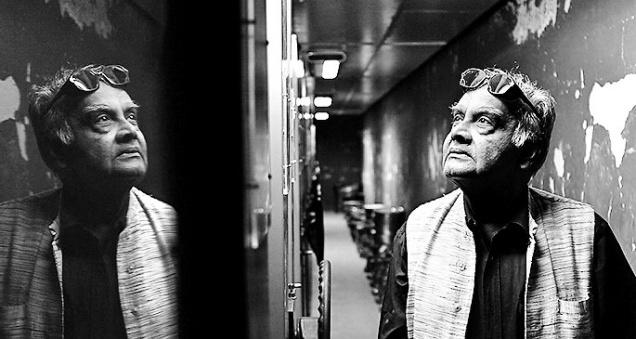By Tanul Thakur
Somewhere near the halfway mark of the documentary, Celluloid Man, we move from P.K. Nair’s professional life to personal life. He now lives in Trivandrum, his terrace faces coconut trees aplenty, which sway leisurely and lazily. We then meet P.K. Nair’s daughter, who reflects back on her childhood, on how her father, who was a much beloved figure at FTII, was just never at home – never there for her, or for her mother. Her tone evokes a peculiar sadness, and it’s not difficult to ascertain that she’s moments away from breaking down. She’s not complaining though. It’s not possible; you cannot keep complaining for more than 30-odd years. More than sadness, her tone indicates extreme weariness. She’s just glad that her father has come back. “We share a strange relationship. We are more like friends now,” says Nair’s daughter.
For me, this particular moment in the film was the story for me. Not the story for this documentary, but just a story in general. Of the curious relationship among a man, his passion, and his family members. Nair family lost a father and a husband, and the nation gained a film archivist. What’s more significant – the loss of Nair’s family or the gain of myriad filmmakers, editors, cinematographers of FTII whose lives were enriched by Nair’s passion? Someone ends up paying a price in the end. Although that does not mean that all extremely motivated, passionate people have unfulfilled personal lives, but it’s just that in some or a lot of cases, there’s an other side too, which is seldom documented.
Pretty early on in the movie, you easily understand how much P.K. Nair loves movies. And, since love is so often entwined with ownership, at least in popular discourse, you wonder – what do I do about it? What’s the next step? Nair was no different. He wanted to become a filmmaker. It’s not unusual, that desire. On a very broad level, people obsessed with the nuances of words want to become writers, people obsessed with how different individual colours segue into one another to shed their individual identity to assume a collective one would want to become painters. Nair, similarly, was drawn to moving images. So, he wanted to become a filmmaker. But, unlike painting and writing, filmmaking cannot be done in isolation; it can be as intensely personal as the above two art forms, but the very medium doesn’t afford the luxury of seclusion. Despite spending time on Mehboob Khan’s set to learn the craft, Nair didn’t go on to become a filmmaker. We don’t know why, we are not presented with a reason in the documentary. But, Nair’s obsession with film prints has its roots in Nair not becoming a filmmaker. In the movie, Rajkumar Hirani says that he would be often astounded by how Nair knew exactly which print corresponded to what song or sequence. Hirani doesn’t remember it for his own films. Maybe because, Hirani makes movies, so his admiration for cinema would be drastically different from Nair’s. Because, Nair just observes. His act of restoration or remembering prints by heart is his way of asserting ownership on those films; it’s his way of creating films, which he once wanted to. In a country like India, which suffers from a severe cultural famine, restoration should be equally sacrosanct as creation. Later in the movie, Nair again briefly touches upon him wanting to be a filmmaker once, but he’s glad that he became an archivist.
That takes us to another significant point. The importance of differences. People, who are interested in cinema (not necessarily as filmmakers), their aspirations are often shot down with a condescending question, ‘So, why don’t you go and make movies?’ This question is often hurled at film critics, often as an invective. Or, to anyone who’s trying to engage with the medium but has never made a film, and maybe doesn’t want to. That’s why P.K. Nair’s life is such an illuminating example. If everyone were doing the same thing, our collective cultural conscience would stagnate. We need different driven people in different occupations. Who knows, Nair could well have been a really good filmmaker, but then there were so many filmmakers already, there was not one archivist. Similarly, some people create, some document – in various capacities. Celluoid Man drives home this point quite beautifully. That documentation is an art form too. And, by documentation, I just don’t mean film archiving, but I mean documenting in an overarching sense through various means. Documentation should not be kept at a different pedestal as creation.
One of the many ways in which documentaries differ from feature length films is their unhinged nature. For the most part, you place a camera in an already existing world and hope for interesting things to happen. Or, you can hope for interesting things to happen in a world that you have created. It’s very clear that Dungarpur is trying to create a world in many of the scenes, which is fine. For a movie like this, the challenges that stared Dungarpur would have been substantial. In a documentary running over 150 minutes, if the only thing its protagonist did was talk, the movie would have been both insufferably boring and tautological. So, to avoid that, Dungarpur astutely places P.K. Nair in different situations so we are constantly seeing different visuals, experiencing different ambiances. But, the world that Dungarpur creates in many of the frames (this problem is more prevalent in the early part of the movie), is not only amateur, but also lazily set up. Also, the one-on-one adaptation of what Nair is saying and what appears on the screen is jarring. So, early on in the movie, Nair is talking about how he went to Nasik in a “paper taxi” to fetch a film print. In the next shot, we see Nair standing beside a taxi on the road, near a millstone that reads ‘Nasik 280 Km’. Or, when Nair is talking about Citizen Kane, we are shown that he’s sitting in a theatre while Citizen Kane is playing in the background. Or, when a student of FTII recounts how Nair would watch a movie, carrying a small notepad and a torch with him noting the condition of the print as the film unfolded. In the next scene, we see Nair watching a film, carrying a small torch and a notepad. The problem with these scenes are two fold – firstly, the subsequent visuals don’t provide any new information, and secondly, it’s very easy to discern that those scenes were specifically designed for the movie, they don’t blend in the movie naturally, rather stick out. So, their clumsy, synthetic construction keeps pulling you out of the story.
But, quibbles aside, one of the more incredible achievements of the film is how it goes about in deconstructing what passion means, to what extent it can propel people, and the childlike innocence it so seamlessly spawns. One of my favorite sequence from the film is P.K. Nair standing in the theatre, near the screen, while a scene from Citizen Kane plays (this scene is different from the one mentioned in the previous paragraph), Nair’s back faces the screen, and as the scene progresses we see Nair recounting dialogues from that particular scene. How many times would he have seen the movie or that particular scene to remember its dialogue? Also, it’s not a particularly grown up thing to, and Nair is 80-years-old. Endearing, delectable lives of people consumed by passion. It makes you oblivious to everything around.
Dungarpur’s decision to infuse the narrative with clips from movies of yore lends a lot of character to the movie. Because by doing so, the movie also celebrates a cinema culture we once had, and one, which we could have so easily lost, had it not been for P.K. Nair. And, by letting those frames breathe, the movie very earnestly reveres those significant flagpoles of our cultural history, something P.K. Nair was awed by. The film, or the filmmaker, in turn, is awed by P.K. Nair. Often, one of the more fitting ways of honoring someone we love is to honor their choices. Those pristine footages bookend this endearing relationship quite fittingly – the one between the filmmaker, the film archivist, and the movies.
[Tanul Thakur is an award-winning Indian film critic. Read more of his work on his blog here]








Leave A Comment
You must be logged in to post a comment.